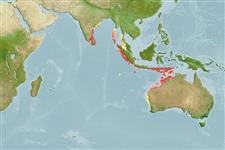>
Eupercaria/misc (Various families in series Eupercaria) >
Labridae (Wrasses)
Etymology: Paracheilinus: Greek, para = the side of + Greek, chaite = hair + Greek, odous = teeth (Ref. 45335).
Environment: milieu / climate zone / depth range / distribution range
Ökologie
seewasser riff-verbunden; tiefenbereich 6 - 35 m (Ref. 90102). Tropical
Eastern Indian Ocean: Indonesia and northwestern Australia.
Size / Gewicht / Alter
Maturity: Lm ? range ? - ? cm
Max length : 8.5 cm TL Männchen/unbestimmt; (Ref. 48636)
Males display with bright yellow anal fins and red spikes on the dorsal fin that vary from a single to 4. More often they have 2 or 3 (Ref. 48636).
Inhabits rubble and weedy bottoms of seaward reefs (Ref. 90102). Also found in coastal reef slopes and estuaries. Occurs in small groups with numerous females, juveniles and several males, often covering a large section of reef. Juveniles are secretive when small and form small groups at later stages (Ref. 48636).
Life cycle and mating behavior
Geschlechtsreife | Fortpflanzung | Ablaichen | Eier | Fecundity | Larven
Oviparous, distinct pairing during breeding (Ref. 205).
Parenti, P. and J.E. Randall, 2000. An annotated checklist of the species of the labroid fish families Labridae and Scaridae. Ichthyol. Bull. J.L.B. Smith Inst. Ichthyol. (68):1-97. (Ref. 35918)
IUCN Rote Liste Status (Ref. 130435: Version 2024-1)
Bedrohung für Menschen
Harmless
Nutzung durch Menschen
Tools
Zusatzinformationen
Download XML
Internet Quellen
Estimates based on models
Preferred temperature (Ref.
123201): 26.4 - 28.6, mean 27.8 °C (based on 38 cells).
Phylogenetic diversity index (Ref.
82804): PD
50 = 0.5000 [Uniqueness, from 0.5 = low to 2.0 = high].
Bayesian length-weight: a=0.00977 (0.00470 - 0.02030), b=3.07 (2.90 - 3.24), in cm total length, based on LWR estimates for this (Sub)family-body shape (Ref.
93245).
Trophic level (Ref.
69278): 3.4 ±0.4 se; based on size and trophs of closest relatives
Widerstandsfähigkeit (Ref.
120179): hoch, Verdopplung der Population dauert weniger als 15 Monate. (Preliminary K or Fecundity.).
Fishing Vulnerability (Ref.
59153): Low vulnerability (10 of 100).
Nutrients (Ref.
124155): Calcium = 132 [76, 269] mg/100g; Iron = 1.03 [0.58, 1.99] mg/100g; Protein = 18.2 [15.2, 20.4] %; Omega3 = 0.172 [0.096, 0.300] g/100g; Selenium = 22.9 [12.2, 45.9] μg/100g; VitaminA = 253 [76, 921] μg/100g; Zinc = 1.98 [1.27, 3.13] mg/100g (wet weight);
